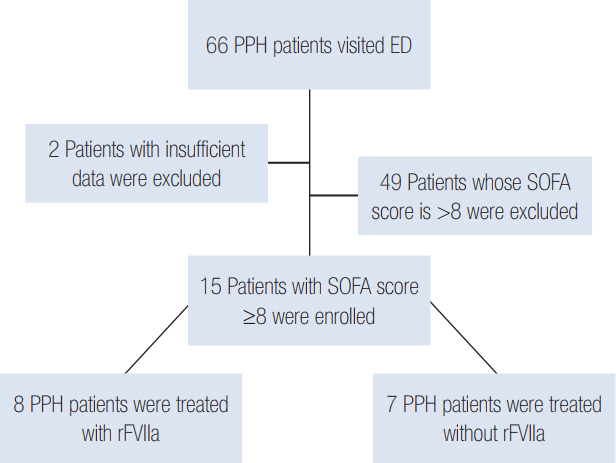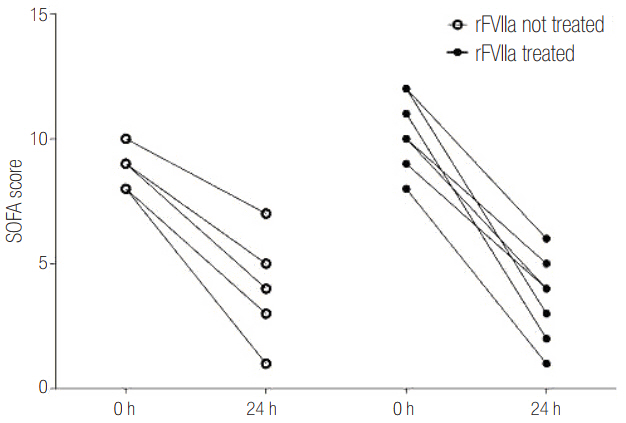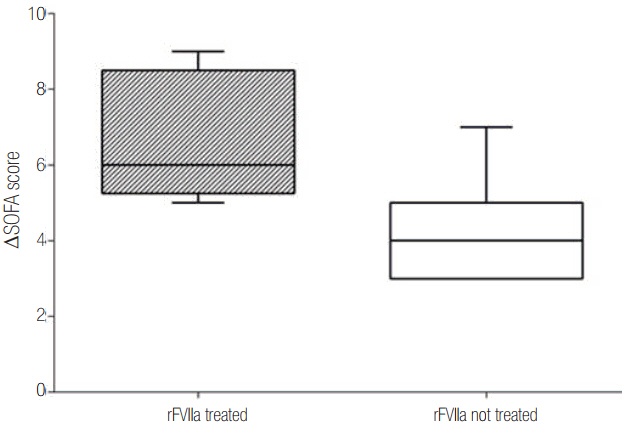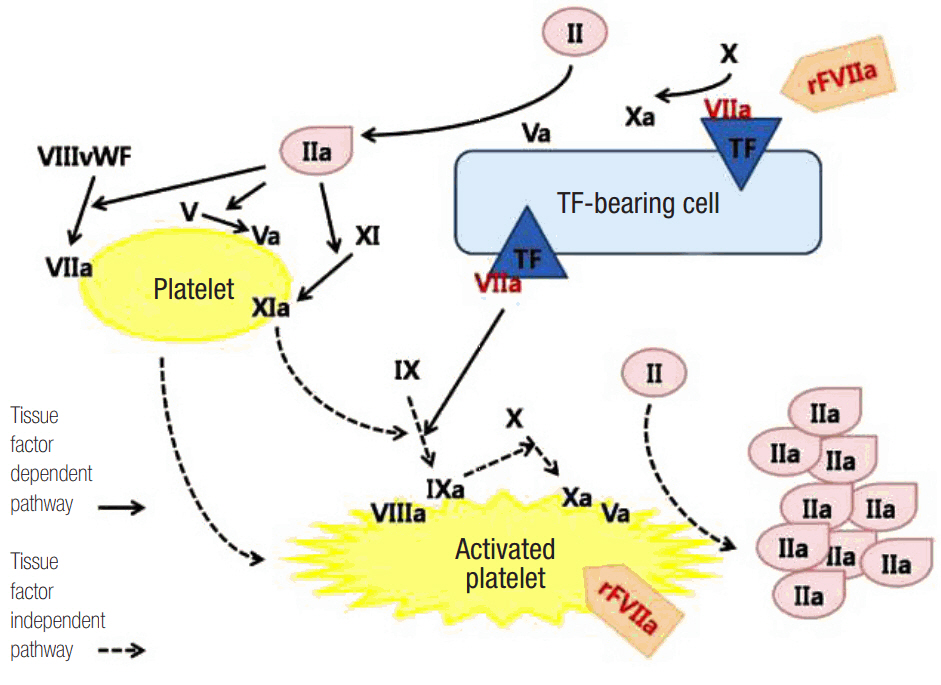Korean J Crit Care Med.
2017 Nov;32(4):333-339. 10.4266/kjccm.2016.00787.
Recombinant Activated Factor VII as a Second Line Treatment for Postpartum Hemorrhage
- Affiliations
-
- 1Department of Emergency Medicine, Pusan National University Hospital, Busan, Korea. seokrany@pusan.ac.kr
- 2Department of Emergency Medicine, Pusan National University School of Medicine, Yangsan, Korea.
- KMID: 2405119
- DOI: http://doi.org/10.4266/kjccm.2016.00787
Abstract
- BACKGROUND
Severe or massive postpartum hemorrhage (PPH) has remained a leading cause of maternal mortality for decades across the world and it results in critical obstetric complications. Recombinant activated factor VII (rFVIIa) has emerged as a gold standard adjunctive hemostatic agent for the treatment of life-threatening PPH refractory to conventional therapies although it remains off-licensed for use in PPH. We studied the effects of rFVIIa on coagulopathy, transfusion volume, prognosis, severity change in Korean PPH patients.
METHODS
A retrospective review of medical records between December 2008 and March 2011 indicating use of rFVIIa in severe PPH was performed. We compared age, rFVIIa treatment, transfusion volume, and Sequential Organ Failure Assessment (SOFA) score at the time of arrival in the emergency department and after 24 hours for patients whose SOFA score was 8 points or higher.
RESULTS
Fifteen women with SOFA score of 8 and above participated in this study and eight received rFVIIa administration whereas seven did not. Patients' mean age was 31.7 ± 7.5 years. There was no statistically significant difference in initial and post-24 hours SOFA scores between patients administered rFVIIa or not. The change in SOFA score between initial presentation and after 24 hours was significantly reduced after rFVIIa administration (P = 0.016).
CONCLUSIONS
This analysis aimed to support that the administration of rFVIIa can reduce the severity of life-threatening PPH in patients. A rapid decision regarding the administration of rFVIIa is needed for a more favorable outcome in severe PPH patients for whom there is no effective standard treatment.
Keyword
MeSH Terms
Figure
Reference
-
References
1. Say L, Chou D, Gemmill A, Tunçalp Ö, Moller AB, Daniels J, et al. Global causes of maternal death: a WHO systematic analysis. Lancet Glob Health. 2014; 2:e323–33.
Article2. Statistics Korea. Korean statistical information service, infant, maternal and perinatal mortality statistics 2014. Daejeon: Statistics Korea;2015.3. Henry A, Birch MR, Sullivan EA, Katz S, Wang YA. Primary postpartum haemorrhage in an Australian tertiary hospital: a case-control study. Aust N Z J Obstet Gynaecol. 2005; 45:233–6.
Article4. World Health Organization. WHO recommendations for the prevention and treatment of postpartum haemorrhage: evidence base [Internet]. Geneva: World Health Organization;2012. [cited 2017 Oct 16]. Available from: www.who.int/reproductivehealth/publications/maternal_perinatal_health/9789241548502/en.5. Welsh A, McLintock C, Gatt S, Somerset D, Popham P, Ogle R. Guidelines for the use of recombinant activated factor VII in massive obstetric haemorrhage. Aust N Z J Obstet Gynaecol. 2008; 48:12–6.
Article6. Yamamoto H, Sagae S, Nishikawa S, Kudo R. Emergency postpartum hysterectomy in obstetric practice. J Obstet Gynaecol Res. 2000; 26:341–5.
Article7. Moscardo F, Perez F, de la Rubia J, Balerdi B, Lorenzo JI, Senent ML, et al. Successful treatment of severe intra-abdominal bleeding associated with disseminated intravascular coagulation using recombinant activated factor VII. Br J Haematol. 2001; 114:174–6.8. Alfirevic Z, Elbourne D, Pavord S, Bolte A, Van Geijn H, Mercier F, et al. Use of recombinant activated factor VII in primary postpartum hemorrhage: the Northern European registry 2000-2004. Obstet Gynecol. 2007; 110:1270–8.
Article9. Vincent JL, Rossaint R, Riou B, Ozier Y, Zideman D, Spahn DR. Recommendations on the use of recombinant activated factor VII as an adjunctive treatment for massive bleeding: a European perspective. Crit Care. 2006; 10:R120.10. Shander A, Goodnough LT, Ratko T, Matuszewski KA, Cohn PS, Diringer M, et al. Consensus recommendations for the off-label use of recombinant human factor VIIa (NovoSeven®) therapy. P T. 2005; 30:644–58.11. Jones AE, Trzeciak S, Kline JA. The Sequential Organ Failure Assessment score for predicting outcome in patients with severe sepsis and evidence of hypoperfusion at the time of emergency department presentation. Crit Care Med. 2009; 37:1649–54.
Article12. Ferreira FL, Bota DP, Bross A, Melot C, Vincent JL. Serial evaluation of the SOFA score to predict outcome in critically ill patients. JAMA. 2001; 286:1754–8.
Article13. de Azevedo JR, Torres OJ, Beraldi RA, Ribas CA, Malafaia O. Prognostic evaluation of severe sepsis and septic shock: procalcitonin clearance vs Δ Sequential Organ Failure Assessment. J Crit Care. 2015; 30:219. e9-12.
Article14. Ogawa M, Akahira S, Takahashi S, Shimoda Y, Sato M, Sato A, et al. Low-dose recombinant activated factor VII temporally stopped bleeding from small artery in severe postpartum hemorrhage: a case report. Blood Coagul Fibrinolysis. 2013; 24:344–6.15. Aledort LM. Comparative thrombotic event incidence after infusion of recombinant factor VIIa versus factor VIII inhibitor bypass activity. J Thromb Haemost. 2004; 2:1700–8.
Article16. Bomken C, Mathai S, Biss T, Loughney A, Hanley J. Recombinant activated factor VII (rFVIIa) in the management of major obstetric haemorrhage: a case series and a proposed guideline for use. Obstet Gynecol Int. 2009; 2009:364843.
Article17. Biss TT, Hanley JP. Recombinant activated factor VII (rFVIIa/NovoSeven) in intractable haemorrhage: use of a clinical scoring system to predict outcome. Vox Sang. 2006; 90:45–52.
- Full Text Links
- Actions
-
Cited
- CITED
-
- Close
- Share
- Similar articles
-
- Successful management of maternal factor VII deficiency in a cesarean section
- Clinical Efficacy of Recombinant Activated Factor VII in Management of Postpartum Hemorrhage
- A Case of Successful Treatment of Childhood Intractable Gastrointestinal Hemorrhage with Low Dose Recombinant Activated Factor VII (NovoSeven (R))
- A case of intracranial hemorrhage in a neonate with congenital factor VII deficiency
- Clinical Experience with Recombinant Activated Factor VII in a Surgical Patient with Coagulation Factor VII Deficiency: A case report





